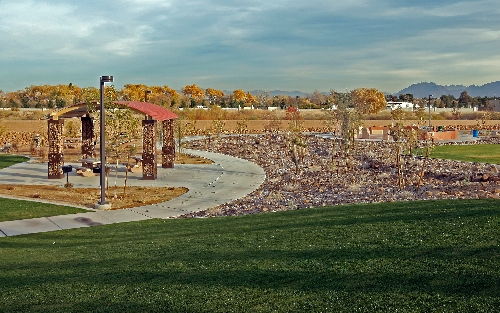Sunset Park improvements unveiled

With traffic noise in the background, a man wearing a cowboy hat stood on a newly enhanced section of Sunset Park and told of being born at this site 75 years ago when it was a ranch.
Then, the main way of traveling across the rough terrain was by horseback.
"I learned how to ride before I learned how to walk," Rollie Gibbs said Tuesday at a ceremony marking $11 million in upgrades to 140 acres of the park.
Gibbs and his brother Sonny, who also spoke, were sons of the ranch’s caretaker, Bert Gibbs. Their stories punctuated the fertile history of the evolving 325-acre park, one of the more popular recreational spots in Clark County.
The latest improvements, known as Phase 1, were funded mostly with federal money from Southern Nevada land sales. The Regional Transportation Commission chipped in $65,000.
New features include a covered children’s play area, a 3.5-acre dog park, paved trails, shaded structures, signs describing the site’s history and a roofed platform overlooking the sand dunes near Warm Springs Road.
Park-goers can access this improved section through a new entrance off Sunset Road, just west of Tomiyasu Lane.
The $11 million second phase is scheduled to begin in the spring.
New walking paths, a large playground and restrooms will be built near the lake. The boat dock will be renovated.
Meanwhile, the existing playground and dog park will be removed. This area of the park attracted homeless campers and became susceptible to crime, said Jane Pike, county Parks and Recreation director.
County officials had planned to pave over parts of the dunes to repel the homeless, said Liz Warren, a local historian, who called that strategy a horrible idea.
This is the last vestige of sand dunes that once fanned out for miles before development displaced them, Warren said, arguing that they should be respected.
A local hydrologist and other activists persuaded the county to preserve the remaining dunes, she said. "The fact they were protected speaks volumes of how important the dunes were to residents."
The parkland has a diverse and colorful history.
Paiute tribes lived here a millennium ago, trading seeds, nuts and turquoise. Japanese pioneer Yonema Tomiyasu grew vegetables on the land, supplying food to Hoover Dam workers.
A railway spur near the dunes — visible from the new trails — enabled trains to carry supplies to the dam while it was under construction.
In 1905, John F. Miller bought the land that would eventually become Sunset Park and built a ranch on it. He sold the property in 1939 to John Kell Houssels, a casino operator.
In the early 1960s, the Houssels family sold the land to a group of investors who wanted to develop a golf course on the site, but couldn’t because of the water restrictions at the time, Warren said.
The county bought it in 1967 .
A notable feature about Sunset Park is its artesian wells.
These underground springs aided bootleggers, said Rollie Gibbs. They would go to mesquite groves, knowing the springs fed the trees, and scoop water flowing from the ground to use in making liquor.
Gibbs said his father, who was a deputy, never bothered the bootleggers. Mysteriously, he was never short on whiskey, Gibbs said, smiling.
"People looked out for each other," he said.